Nutrition Report: Carbohydrate Role, Intake and Food Sources
VerifiedAdded on 2020/11/12
|12
|2723
|499
Report
AI Summary
This report provides a comprehensive overview of carbohydrate nutrition, beginning with an introduction to the science of nutrition and the specific focus on carbohydrates as a vital nutrient. It delves into the chemical structure of carbohydrates, classifying them into monosaccharides, disaccharides, and polysaccharides, and explains their digestion and metabolism within the human body. The report emphasizes the crucial role of carbohydrates in providing energy and supporting cellular functions, detailing suggested dietary intake targets based on age groups. It then lists various food sources rich in carbohydrates, including grains, fruits, dairy products, and starchy vegetables. The analysis extends to evaluating articles on low-carb diets and expert insights, along with a 24-hour food record for a 25-year-old woman, detailing her carbohydrate intake across different meals and snacks. The report concludes with a summary of the findings and relevant references.
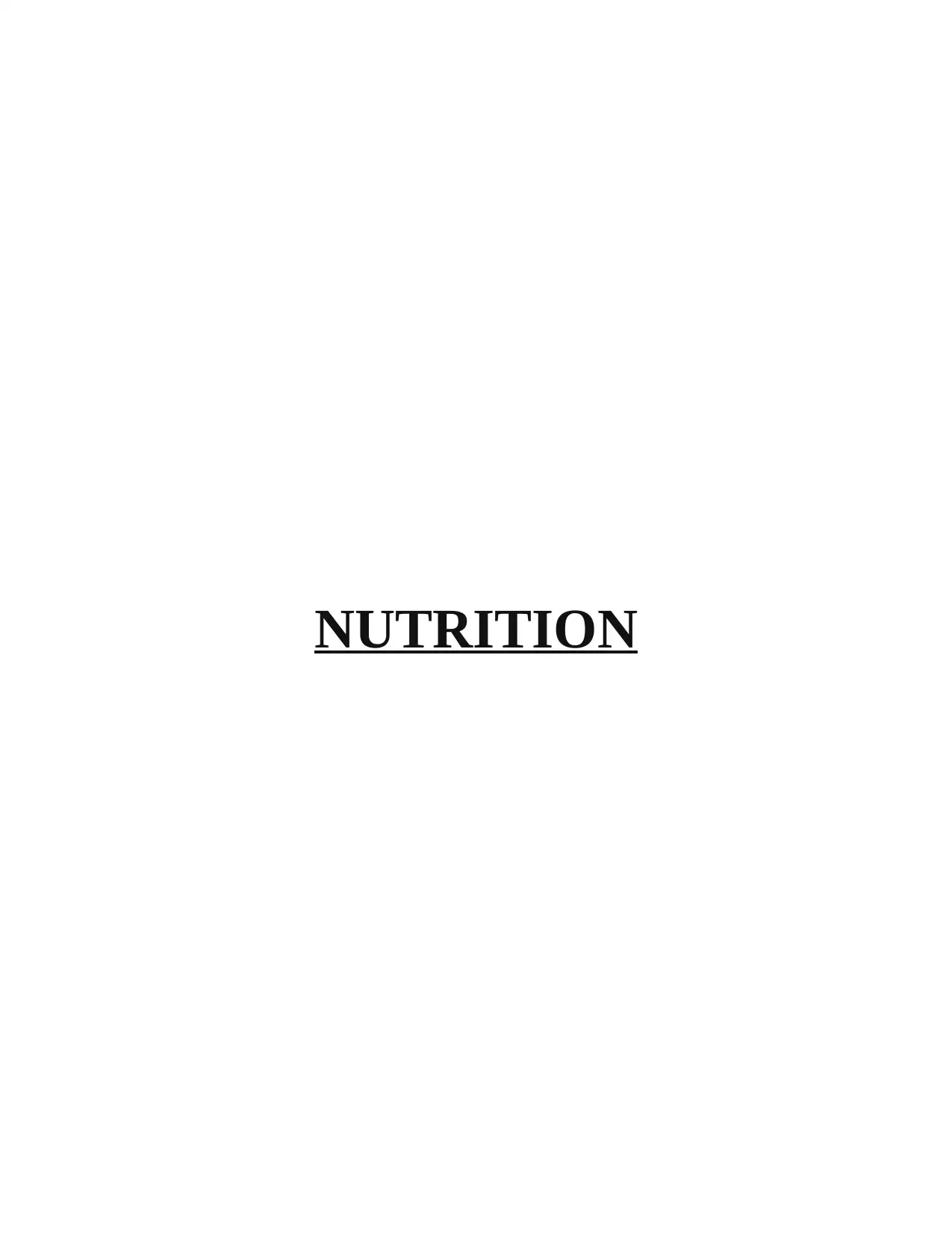
NUTRITION
Paraphrase This Document
Need a fresh take? Get an instant paraphrase of this document with our AI Paraphraser

TABLE OF CONTENTS
NUTRITION....................................................................................................................................1
INTRODUCTION...........................................................................................................................3
PART A...........................................................................................................................................3
1. Role of Carbohydrate in body............................................................................................3
i ) Chemical structure of carbohydrate...................................................................................3
ii) Digestion and metabolism of carbohydrate.......................................................................4
iii) Role of carbohydrate in body............................................................................................4
iv) Suggested dietary intake targets for carbohydrate............................................................5
v) Food sources that provide carbohydrate............................................................................5
2. Analysis of articles on the basis of nutritional information.............................................5
PART B............................................................................................................................................7
a) 24-hour food record for adult 25-year-old woman.............................................................7
CONCLUSION..............................................................................................................................11
REFERENCES (APA)...................................................................................................................12
NUTRITION....................................................................................................................................1
INTRODUCTION...........................................................................................................................3
PART A...........................................................................................................................................3
1. Role of Carbohydrate in body............................................................................................3
i ) Chemical structure of carbohydrate...................................................................................3
ii) Digestion and metabolism of carbohydrate.......................................................................4
iii) Role of carbohydrate in body............................................................................................4
iv) Suggested dietary intake targets for carbohydrate............................................................5
v) Food sources that provide carbohydrate............................................................................5
2. Analysis of articles on the basis of nutritional information.............................................5
PART B............................................................................................................................................7
a) 24-hour food record for adult 25-year-old woman.............................................................7
CONCLUSION..............................................................................................................................11
REFERENCES (APA)...................................................................................................................12
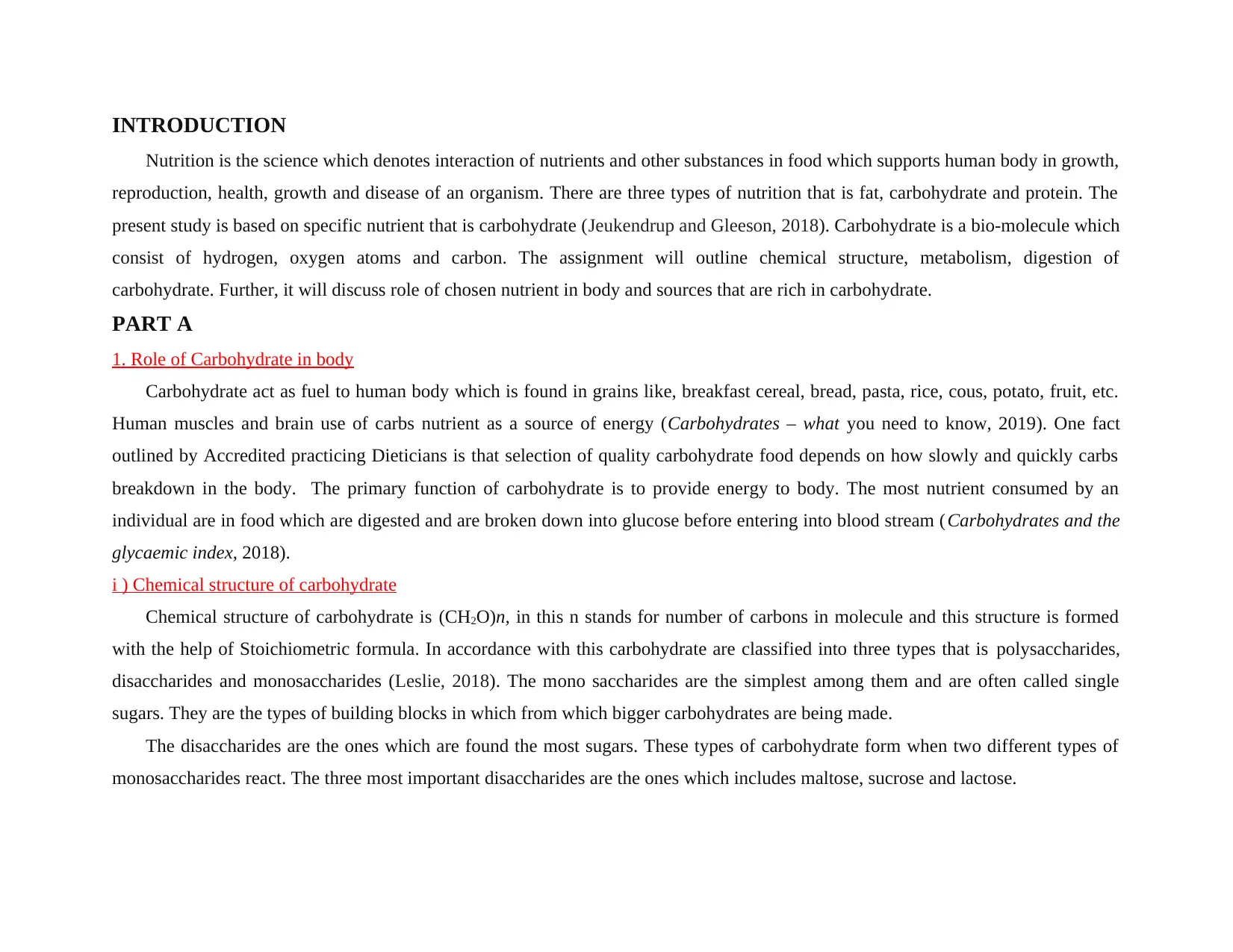
INTRODUCTION
Nutrition is the science which denotes interaction of nutrients and other substances in food which supports human body in growth,
reproduction, health, growth and disease of an organism. There are three types of nutrition that is fat, carbohydrate and protein. The
present study is based on specific nutrient that is carbohydrate (Jeukendrup and Gleeson, 2018). Carbohydrate is a bio-molecule which
consist of hydrogen, oxygen atoms and carbon. The assignment will outline chemical structure, metabolism, digestion of
carbohydrate. Further, it will discuss role of chosen nutrient in body and sources that are rich in carbohydrate.
PART A
1. Role of Carbohydrate in body
Carbohydrate act as fuel to human body which is found in grains like, breakfast cereal, bread, pasta, rice, cous, potato, fruit, etc.
Human muscles and brain use of carbs nutrient as a source of energy (Carbohydrates – what you need to know, 2019). One fact
outlined by Accredited practicing Dieticians is that selection of quality carbohydrate food depends on how slowly and quickly carbs
breakdown in the body. The primary function of carbohydrate is to provide energy to body. The most nutrient consumed by an
individual are in food which are digested and are broken down into glucose before entering into blood stream (Carbohydrates and the
glycaemic index, 2018).
i ) Chemical structure of carbohydrate
Chemical structure of carbohydrate is (CH2O)n, in this n stands for number of carbons in molecule and this structure is formed
with the help of Stoichiometric formula. In accordance with this carbohydrate are classified into three types that is polysaccharides,
disaccharides and monosaccharides (Leslie, 2018). The mono saccharides are the simplest among them and are often called single
sugars. They are the types of building blocks in which from which bigger carbohydrates are being made.
The disaccharides are the ones which are found the most sugars. These types of carbohydrate form when two different types of
monosaccharides react. The three most important disaccharides are the ones which includes maltose, sucrose and lactose.
Nutrition is the science which denotes interaction of nutrients and other substances in food which supports human body in growth,
reproduction, health, growth and disease of an organism. There are three types of nutrition that is fat, carbohydrate and protein. The
present study is based on specific nutrient that is carbohydrate (Jeukendrup and Gleeson, 2018). Carbohydrate is a bio-molecule which
consist of hydrogen, oxygen atoms and carbon. The assignment will outline chemical structure, metabolism, digestion of
carbohydrate. Further, it will discuss role of chosen nutrient in body and sources that are rich in carbohydrate.
PART A
1. Role of Carbohydrate in body
Carbohydrate act as fuel to human body which is found in grains like, breakfast cereal, bread, pasta, rice, cous, potato, fruit, etc.
Human muscles and brain use of carbs nutrient as a source of energy (Carbohydrates – what you need to know, 2019). One fact
outlined by Accredited practicing Dieticians is that selection of quality carbohydrate food depends on how slowly and quickly carbs
breakdown in the body. The primary function of carbohydrate is to provide energy to body. The most nutrient consumed by an
individual are in food which are digested and are broken down into glucose before entering into blood stream (Carbohydrates and the
glycaemic index, 2018).
i ) Chemical structure of carbohydrate
Chemical structure of carbohydrate is (CH2O)n, in this n stands for number of carbons in molecule and this structure is formed
with the help of Stoichiometric formula. In accordance with this carbohydrate are classified into three types that is polysaccharides,
disaccharides and monosaccharides (Leslie, 2018). The mono saccharides are the simplest among them and are often called single
sugars. They are the types of building blocks in which from which bigger carbohydrates are being made.
The disaccharides are the ones which are found the most sugars. These types of carbohydrate form when two different types of
monosaccharides react. The three most important disaccharides are the ones which includes maltose, sucrose and lactose.
⊘ This is a preview!⊘
Do you want full access?
Subscribe today to unlock all pages.

Trusted by 1+ million students worldwide

The polysaccharides are the ones which undergoes a series of reaction while being in condensation reactions. This process is
known as condensation polymerization reaction. These building blocks are also known as monomers which explains that the
properties of the molecule polysaccharide depend on its length, its extent of the branching, a folding which results in a molecule which
is more compact and if the chain is coiled or straight.
ii) Digestion and metabolism of carbohydrate
The digestion of the carbohydrate begins in the mouth. The action of food chewing tends to stimulate the saliva's flow and
within the saliva the enzyme which is amylase tends to start the process of breaking down the carbohydrates. The digestion of the
nutrient in the mouth is minor and as it does not remain in the mouth for a very long time.
In the digestive tract the actions of swallowing and chewing takes place. It ensures that the food while being chewed and
swallowed is releasing the stomach acid which is continuing to break down the carbohydrate. Once the carbohydrate arrived in the
small intestine, more enzymes tends to be released in order to further break them down into molecules of glucose.
Its rate of digestion and absorption impacts carbohydrate metabolism. The rapid breakdown of the nutrient tends to create an
overload of the glucose in the bloodstream. The pancreas tends to respond by pumping the insulin in order to quickly lower the blood
sugar.
iii) Role of carbohydrate in body
In the human body the main function of the carbohydrate is to provide required energy to the body. They also play an
important role as in both the functioning and structure of the cells, organs and tissues as well as the formation of carbohydrate on the
surface of cells. It is one of the most essential and required food for the human body as it ensures that the human body is gaining
required energy from the set source.
known as condensation polymerization reaction. These building blocks are also known as monomers which explains that the
properties of the molecule polysaccharide depend on its length, its extent of the branching, a folding which results in a molecule which
is more compact and if the chain is coiled or straight.
ii) Digestion and metabolism of carbohydrate
The digestion of the carbohydrate begins in the mouth. The action of food chewing tends to stimulate the saliva's flow and
within the saliva the enzyme which is amylase tends to start the process of breaking down the carbohydrates. The digestion of the
nutrient in the mouth is minor and as it does not remain in the mouth for a very long time.
In the digestive tract the actions of swallowing and chewing takes place. It ensures that the food while being chewed and
swallowed is releasing the stomach acid which is continuing to break down the carbohydrate. Once the carbohydrate arrived in the
small intestine, more enzymes tends to be released in order to further break them down into molecules of glucose.
Its rate of digestion and absorption impacts carbohydrate metabolism. The rapid breakdown of the nutrient tends to create an
overload of the glucose in the bloodstream. The pancreas tends to respond by pumping the insulin in order to quickly lower the blood
sugar.
iii) Role of carbohydrate in body
In the human body the main function of the carbohydrate is to provide required energy to the body. They also play an
important role as in both the functioning and structure of the cells, organs and tissues as well as the formation of carbohydrate on the
surface of cells. It is one of the most essential and required food for the human body as it ensures that the human body is gaining
required energy from the set source.
Paraphrase This Document
Need a fresh take? Get an instant paraphrase of this document with our AI Paraphraser

iv) Suggested dietary intake targets for carbohydrate
The dietary intake targets for carbohydrate needs to be as per the requirement of the body and the individual. Carbohydrate is
good for health but if consumed in large amounts they can cause bad health as well. It is important to set optimum dietary intake
targets in order to ensure that the chosen foods are providing the person with the appropriate carbohydrate.
In order to set the right intake targets a person between the age of 7-15 can take 100 grams of carbohydrates. A person between
the ages between 15-30 can take 200 gm of carbohydrate and the ages between 30 and above can take 150 grams of carbohydrate
because of the requirements of their body. The set dietary requirement can ensure that the desired growth and development is taking
place. It is important for an individual to ensure the diet which is being in-taken is rich in carbohydrate and the above-mentioned
intake targets can ensure set a good health.
v) Food sources that provide carbohydrate
The food which are rich in carbohydrates includes dairy foods. Dairy foods are both rich in carbohydrates and proteins and
they allow the individual to get the required carbohydrate. The fruit juice and the whole fruits are also one of the major sources of a
carbohydrate. The grains which are the parts of carbohydrate includes cereals, crackers, rice and breads (Which foods have Carbs?
2015). This is one of the best effective ways to consume carbohydrate and ensure good health as well. The other foods which are rich
in carbohydrates includes legumes and starchy vegetables which are corn and potatoes. Potatoes are being eaten as carbohydrates from
a very long time and they are consumed as a very good source of carbohydrate (Wahlqvist, 2011). In terms of beverages, soda can
provide the individual seeking to have a carbohydrate rich diet with the optimum amount of carbohydrates (Moore, 2015). Also, foods
such as cookies, candies and other desserts are some major providers of carbohydrate nutrient.
2. Analysis of articles on the basis of nutritional information
Low Carb Diets, 2019, study is based on Atkins plan for Low carb diets. These are the individuals who call themselves has low
carbs experts because the individuals are focused on unlocking benefits of low carb lifestyle. The study is specifically focused on
losing weight and how low carb diet can helps people in losing weight. It outlined information amount carb intake which is sufficient
The dietary intake targets for carbohydrate needs to be as per the requirement of the body and the individual. Carbohydrate is
good for health but if consumed in large amounts they can cause bad health as well. It is important to set optimum dietary intake
targets in order to ensure that the chosen foods are providing the person with the appropriate carbohydrate.
In order to set the right intake targets a person between the age of 7-15 can take 100 grams of carbohydrates. A person between
the ages between 15-30 can take 200 gm of carbohydrate and the ages between 30 and above can take 150 grams of carbohydrate
because of the requirements of their body. The set dietary requirement can ensure that the desired growth and development is taking
place. It is important for an individual to ensure the diet which is being in-taken is rich in carbohydrate and the above-mentioned
intake targets can ensure set a good health.
v) Food sources that provide carbohydrate
The food which are rich in carbohydrates includes dairy foods. Dairy foods are both rich in carbohydrates and proteins and
they allow the individual to get the required carbohydrate. The fruit juice and the whole fruits are also one of the major sources of a
carbohydrate. The grains which are the parts of carbohydrate includes cereals, crackers, rice and breads (Which foods have Carbs?
2015). This is one of the best effective ways to consume carbohydrate and ensure good health as well. The other foods which are rich
in carbohydrates includes legumes and starchy vegetables which are corn and potatoes. Potatoes are being eaten as carbohydrates from
a very long time and they are consumed as a very good source of carbohydrate (Wahlqvist, 2011). In terms of beverages, soda can
provide the individual seeking to have a carbohydrate rich diet with the optimum amount of carbohydrates (Moore, 2015). Also, foods
such as cookies, candies and other desserts are some major providers of carbohydrate nutrient.
2. Analysis of articles on the basis of nutritional information
Low Carb Diets, 2019, study is based on Atkins plan for Low carb diets. These are the individuals who call themselves has low
carbs experts because the individuals are focused on unlocking benefits of low carb lifestyle. The study is specifically focused on
losing weight and how low carb diet can helps people in losing weight. It outlined information amount carb intake which is sufficient
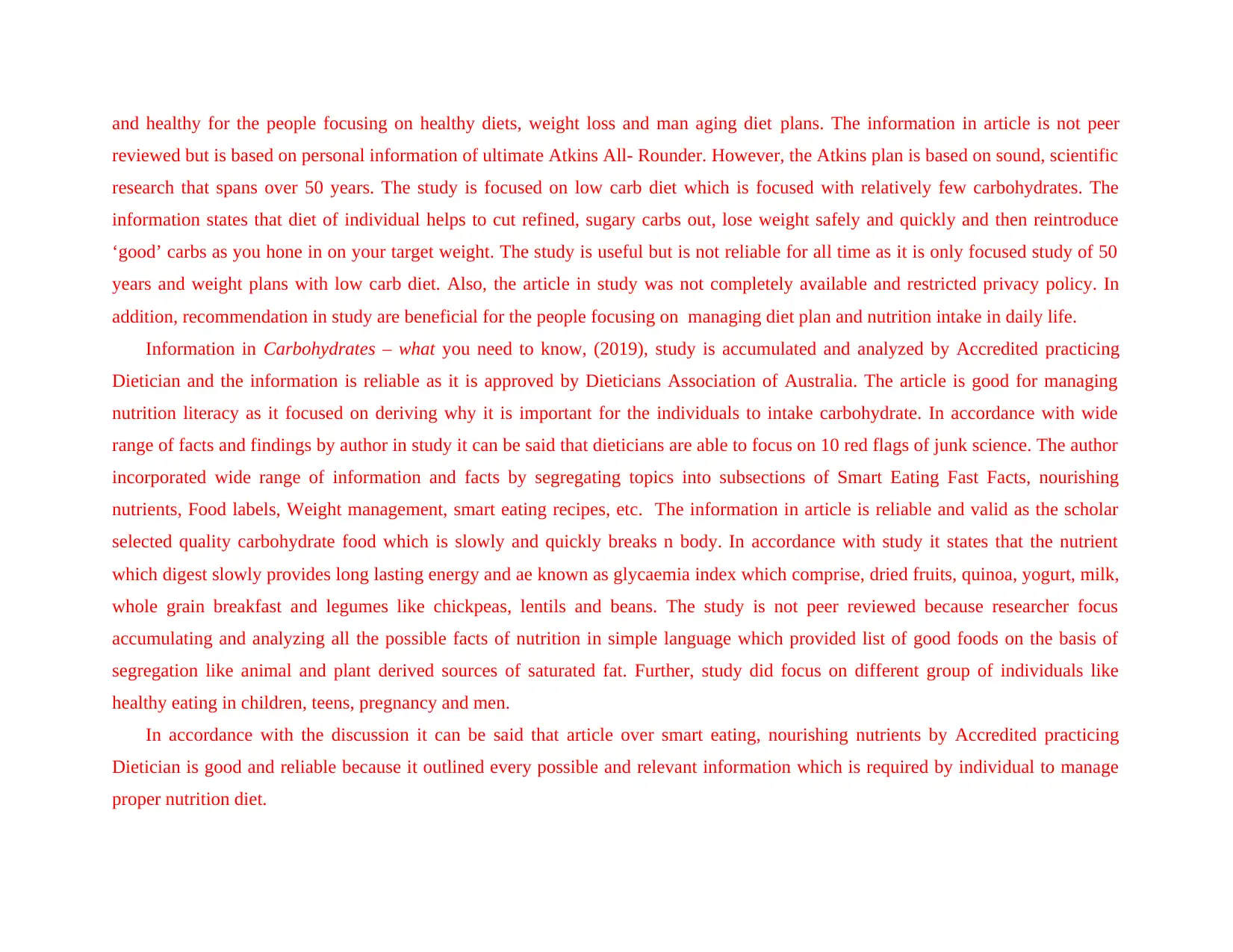
and healthy for the people focusing on healthy diets, weight loss and man aging diet plans. The information in article is not peer
reviewed but is based on personal information of ultimate Atkins All- Rounder. However, the Atkins plan is based on sound, scientific
research that spans over 50 years. The study is focused on low carb diet which is focused with relatively few carbohydrates. The
information states that diet of individual helps to cut refined, sugary carbs out, lose weight safely and quickly and then reintroduce
‘good’ carbs as you hone in on your target weight. The study is useful but is not reliable for all time as it is only focused study of 50
years and weight plans with low carb diet. Also, the article in study was not completely available and restricted privacy policy. In
addition, recommendation in study are beneficial for the people focusing on managing diet plan and nutrition intake in daily life.
Information in Carbohydrates – what you need to know, (2019), study is accumulated and analyzed by Accredited practicing
Dietician and the information is reliable as it is approved by Dieticians Association of Australia. The article is good for managing
nutrition literacy as it focused on deriving why it is important for the individuals to intake carbohydrate. In accordance with wide
range of facts and findings by author in study it can be said that dieticians are able to focus on 10 red flags of junk science. The author
incorporated wide range of information and facts by segregating topics into subsections of Smart Eating Fast Facts, nourishing
nutrients, Food labels, Weight management, smart eating recipes, etc. The information in article is reliable and valid as the scholar
selected quality carbohydrate food which is slowly and quickly breaks n body. In accordance with study it states that the nutrient
which digest slowly provides long lasting energy and ae known as glycaemia index which comprise, dried fruits, quinoa, yogurt, milk,
whole grain breakfast and legumes like chickpeas, lentils and beans. The study is not peer reviewed because researcher focus
accumulating and analyzing all the possible facts of nutrition in simple language which provided list of good foods on the basis of
segregation like animal and plant derived sources of saturated fat. Further, study did focus on different group of individuals like
healthy eating in children, teens, pregnancy and men.
In accordance with the discussion it can be said that article over smart eating, nourishing nutrients by Accredited practicing
Dietician is good and reliable because it outlined every possible and relevant information which is required by individual to manage
proper nutrition diet.
reviewed but is based on personal information of ultimate Atkins All- Rounder. However, the Atkins plan is based on sound, scientific
research that spans over 50 years. The study is focused on low carb diet which is focused with relatively few carbohydrates. The
information states that diet of individual helps to cut refined, sugary carbs out, lose weight safely and quickly and then reintroduce
‘good’ carbs as you hone in on your target weight. The study is useful but is not reliable for all time as it is only focused study of 50
years and weight plans with low carb diet. Also, the article in study was not completely available and restricted privacy policy. In
addition, recommendation in study are beneficial for the people focusing on managing diet plan and nutrition intake in daily life.
Information in Carbohydrates – what you need to know, (2019), study is accumulated and analyzed by Accredited practicing
Dietician and the information is reliable as it is approved by Dieticians Association of Australia. The article is good for managing
nutrition literacy as it focused on deriving why it is important for the individuals to intake carbohydrate. In accordance with wide
range of facts and findings by author in study it can be said that dieticians are able to focus on 10 red flags of junk science. The author
incorporated wide range of information and facts by segregating topics into subsections of Smart Eating Fast Facts, nourishing
nutrients, Food labels, Weight management, smart eating recipes, etc. The information in article is reliable and valid as the scholar
selected quality carbohydrate food which is slowly and quickly breaks n body. In accordance with study it states that the nutrient
which digest slowly provides long lasting energy and ae known as glycaemia index which comprise, dried fruits, quinoa, yogurt, milk,
whole grain breakfast and legumes like chickpeas, lentils and beans. The study is not peer reviewed because researcher focus
accumulating and analyzing all the possible facts of nutrition in simple language which provided list of good foods on the basis of
segregation like animal and plant derived sources of saturated fat. Further, study did focus on different group of individuals like
healthy eating in children, teens, pregnancy and men.
In accordance with the discussion it can be said that article over smart eating, nourishing nutrients by Accredited practicing
Dietician is good and reliable because it outlined every possible and relevant information which is required by individual to manage
proper nutrition diet.
⊘ This is a preview!⊘
Do you want full access?
Subscribe today to unlock all pages.

Trusted by 1+ million students worldwide
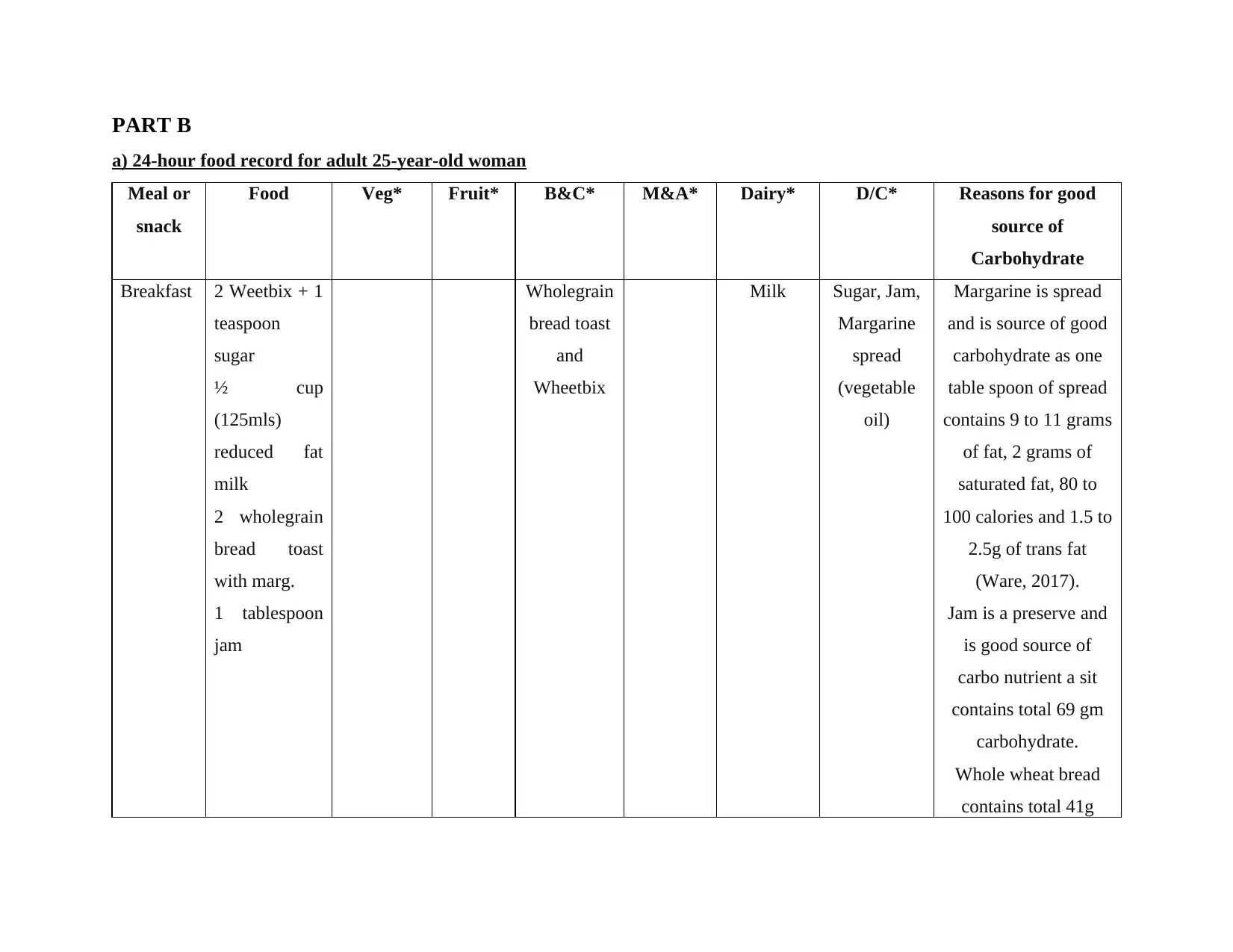
PART B
a) 24-hour food record for adult 25-year-old woman
Meal or
snack
Food Veg* Fruit* B&C* M&A* Dairy* D/C* Reasons for good
source of
Carbohydrate
Breakfast 2 Weetbix + 1
teaspoon
sugar
½ cup
(125mls)
reduced fat
milk
2 wholegrain
bread toast
with marg.
1 tablespoon
jam
Wholegrain
bread toast
and
Wheetbix
Milk Sugar, Jam,
Margarine
spread
(vegetable
oil)
Margarine is spread
and is source of good
carbohydrate as one
table spoon of spread
contains 9 to 11 grams
of fat, 2 grams of
saturated fat, 80 to
100 calories and 1.5 to
2.5g of trans fat
(Ware, 2017).
Jam is a preserve and
is good source of
carbo nutrient a sit
contains total 69 gm
carbohydrate.
Whole wheat bread
contains total 41g
a) 24-hour food record for adult 25-year-old woman
Meal or
snack
Food Veg* Fruit* B&C* M&A* Dairy* D/C* Reasons for good
source of
Carbohydrate
Breakfast 2 Weetbix + 1
teaspoon
sugar
½ cup
(125mls)
reduced fat
milk
2 wholegrain
bread toast
with marg.
1 tablespoon
jam
Wholegrain
bread toast
and
Wheetbix
Milk Sugar, Jam,
Margarine
spread
(vegetable
oil)
Margarine is spread
and is source of good
carbohydrate as one
table spoon of spread
contains 9 to 11 grams
of fat, 2 grams of
saturated fat, 80 to
100 calories and 1.5 to
2.5g of trans fat
(Ware, 2017).
Jam is a preserve and
is good source of
carbo nutrient a sit
contains total 69 gm
carbohydrate.
Whole wheat bread
contains total 41g
Paraphrase This Document
Need a fresh take? Get an instant paraphrase of this document with our AI Paraphraser

carbohydrate. Further,
Wheetbix contains
total 10.0g carbs.
Sugar is also a good
source of
carbohydrate as it
consists of around
33% of carbohydrate
in per 100 grams.
Morning 1 apple
Small
individual
packet crisps
Apple fruit
crisps
Apples is a good
breakfast option as it
contains 52 calories in
per serving. It is a
good source of
potassium, total
carbohydrate, fibre,
Vitamin C, and
magnesium.
Lunch 2 white bread
(4 slices)
sandwiches
with
White bread Salami Margarine
and Coke
White bread is one of
those breads which is
made from the wheat
flour. It is good for
Wheetbix contains
total 10.0g carbs.
Sugar is also a good
source of
carbohydrate as it
consists of around
33% of carbohydrate
in per 100 grams.
Morning 1 apple
Small
individual
packet crisps
Apple fruit
crisps
Apples is a good
breakfast option as it
contains 52 calories in
per serving. It is a
good source of
potassium, total
carbohydrate, fibre,
Vitamin C, and
magnesium.
Lunch 2 white bread
(4 slices)
sandwiches
with
White bread Salami Margarine
and Coke
White bread is one of
those breads which is
made from the wheat
flour. It is good for
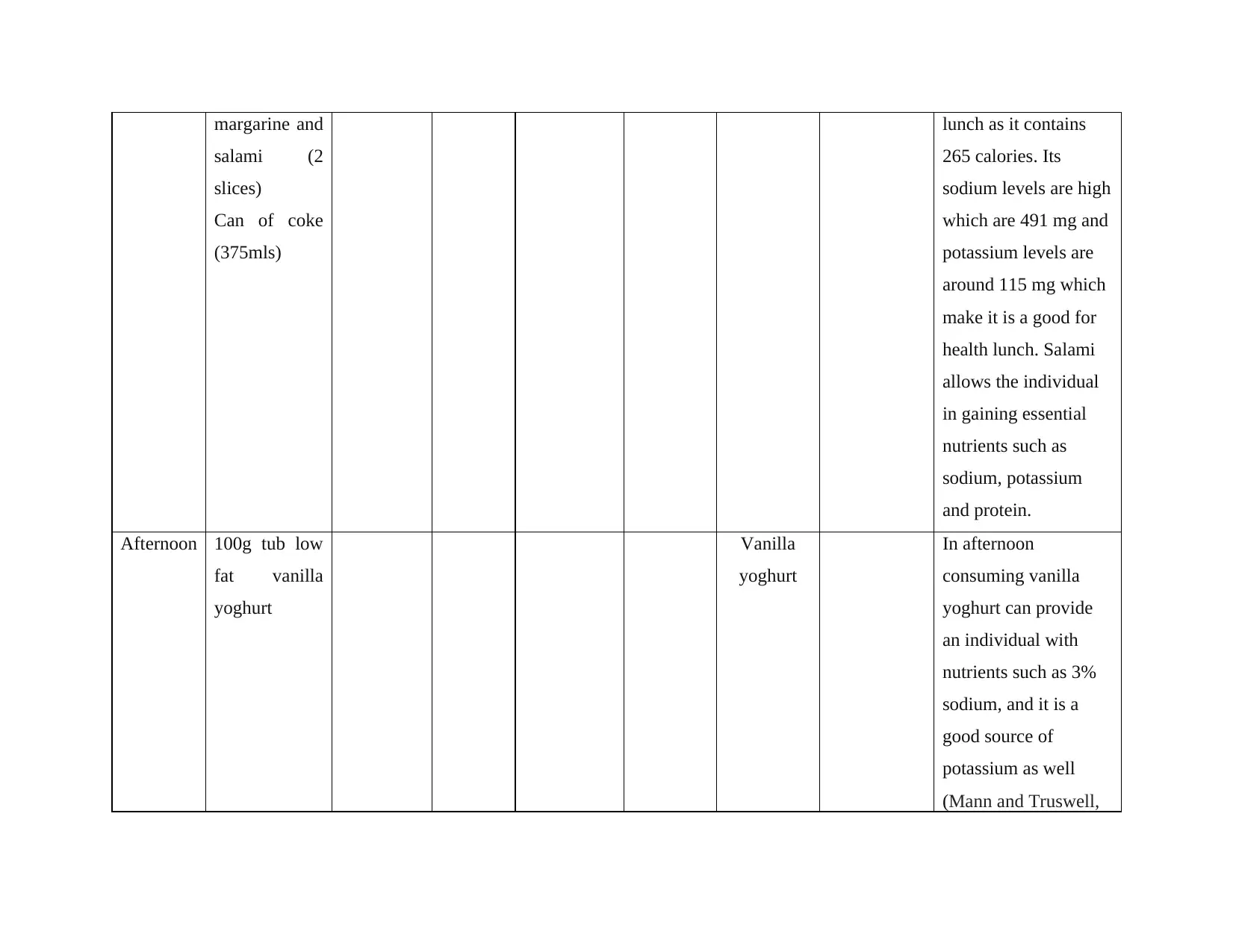
margarine and
salami (2
slices)
Can of coke
(375mls)
lunch as it contains
265 calories. Its
sodium levels are high
which are 491 mg and
potassium levels are
around 115 mg which
make it is a good for
health lunch. Salami
allows the individual
in gaining essential
nutrients such as
sodium, potassium
and protein.
Afternoon 100g tub low
fat vanilla
yoghurt
Vanilla
yoghurt
In afternoon
consuming vanilla
yoghurt can provide
an individual with
nutrients such as 3%
sodium, and it is a
good source of
potassium as well
(Mann and Truswell,
salami (2
slices)
Can of coke
(375mls)
lunch as it contains
265 calories. Its
sodium levels are high
which are 491 mg and
potassium levels are
around 115 mg which
make it is a good for
health lunch. Salami
allows the individual
in gaining essential
nutrients such as
sodium, potassium
and protein.
Afternoon 100g tub low
fat vanilla
yoghurt
Vanilla
yoghurt
In afternoon
consuming vanilla
yoghurt can provide
an individual with
nutrients such as 3%
sodium, and it is a
good source of
potassium as well
(Mann and Truswell,
⊘ This is a preview!⊘
Do you want full access?
Subscribe today to unlock all pages.

Trusted by 1+ million students worldwide
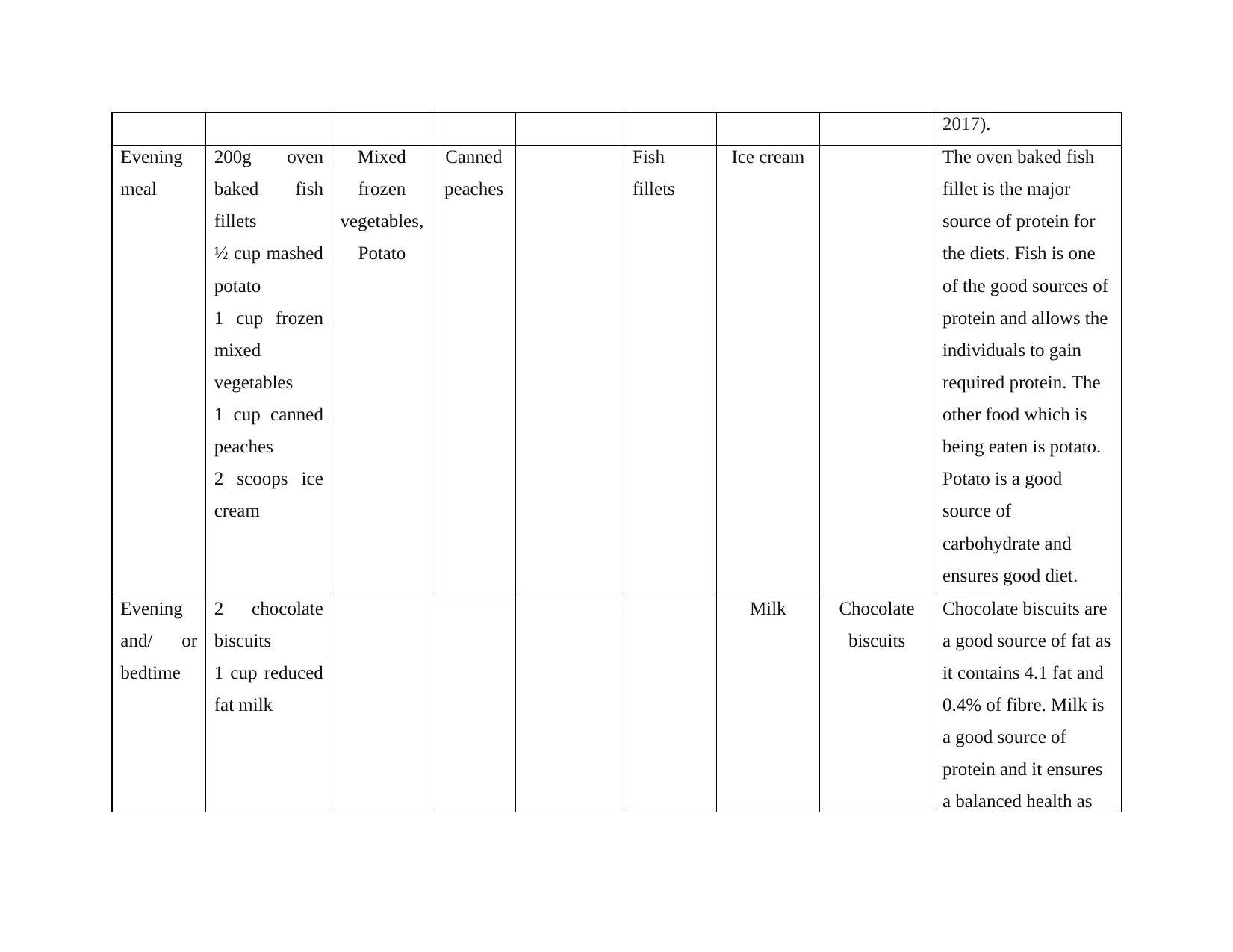
2017).
Evening
meal
200g oven
baked fish
fillets
½ cup mashed
potato
1 cup frozen
mixed
vegetables
1 cup canned
peaches
2 scoops ice
cream
Mixed
frozen
vegetables,
Potato
Canned
peaches
Fish
fillets
Ice cream The oven baked fish
fillet is the major
source of protein for
the diets. Fish is one
of the good sources of
protein and allows the
individuals to gain
required protein. The
other food which is
being eaten is potato.
Potato is a good
source of
carbohydrate and
ensures good diet.
Evening
and/ or
bedtime
2 chocolate
biscuits
1 cup reduced
fat milk
Milk Chocolate
biscuits
Chocolate biscuits are
a good source of fat as
it contains 4.1 fat and
0.4% of fibre. Milk is
a good source of
protein and it ensures
a balanced health as
Evening
meal
200g oven
baked fish
fillets
½ cup mashed
potato
1 cup frozen
mixed
vegetables
1 cup canned
peaches
2 scoops ice
cream
Mixed
frozen
vegetables,
Potato
Canned
peaches
Fish
fillets
Ice cream The oven baked fish
fillet is the major
source of protein for
the diets. Fish is one
of the good sources of
protein and allows the
individuals to gain
required protein. The
other food which is
being eaten is potato.
Potato is a good
source of
carbohydrate and
ensures good diet.
Evening
and/ or
bedtime
2 chocolate
biscuits
1 cup reduced
fat milk
Milk Chocolate
biscuits
Chocolate biscuits are
a good source of fat as
it contains 4.1 fat and
0.4% of fibre. Milk is
a good source of
protein and it ensures
a balanced health as
Paraphrase This Document
Need a fresh take? Get an instant paraphrase of this document with our AI Paraphraser
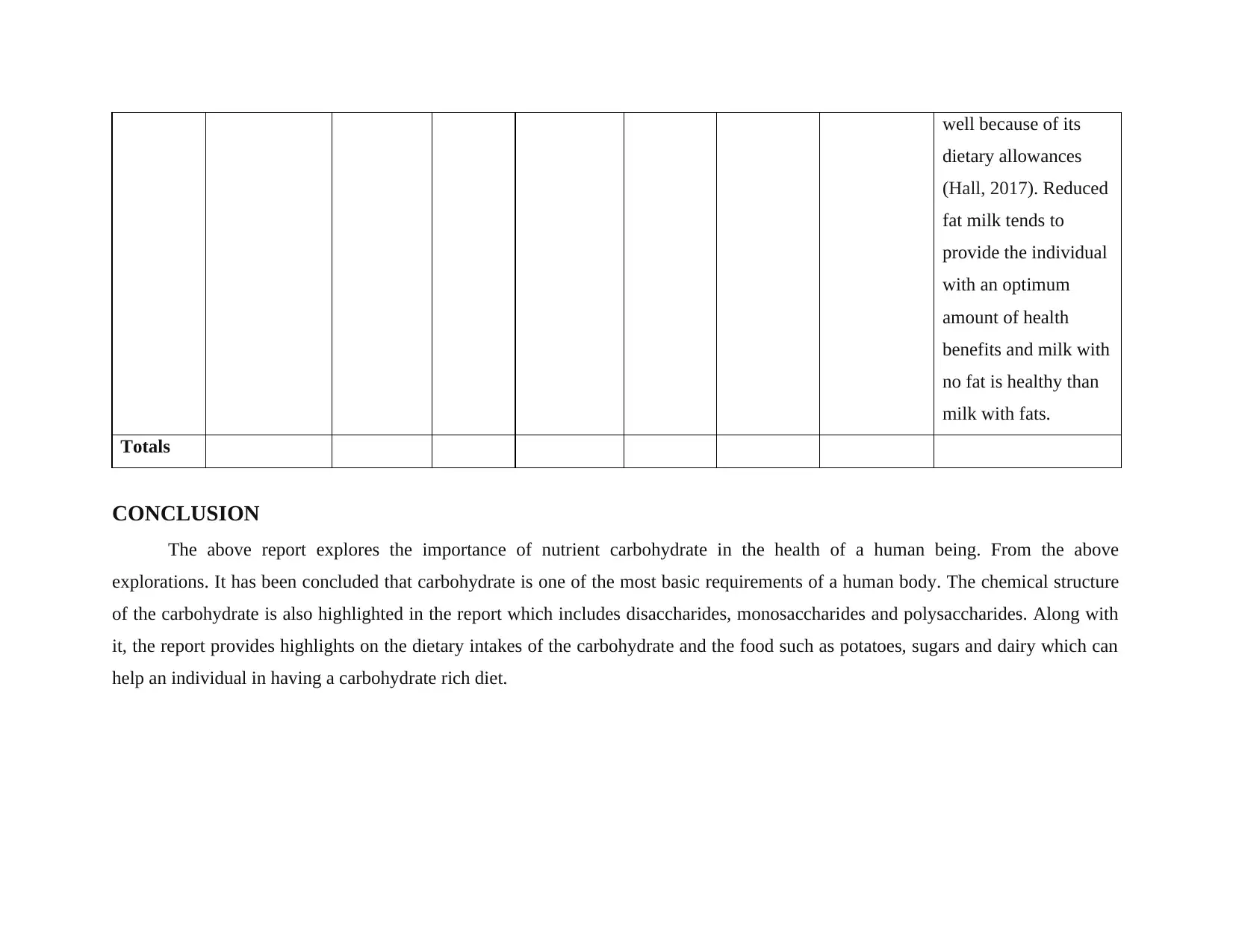
well because of its
dietary allowances
(Hall, 2017). Reduced
fat milk tends to
provide the individual
with an optimum
amount of health
benefits and milk with
no fat is healthy than
milk with fats.
Totals
CONCLUSION
The above report explores the importance of nutrient carbohydrate in the health of a human being. From the above
explorations. It has been concluded that carbohydrate is one of the most basic requirements of a human body. The chemical structure
of the carbohydrate is also highlighted in the report which includes disaccharides, monosaccharides and polysaccharides. Along with
it, the report provides highlights on the dietary intakes of the carbohydrate and the food such as potatoes, sugars and dairy which can
help an individual in having a carbohydrate rich diet.
dietary allowances
(Hall, 2017). Reduced
fat milk tends to
provide the individual
with an optimum
amount of health
benefits and milk with
no fat is healthy than
milk with fats.
Totals
CONCLUSION
The above report explores the importance of nutrient carbohydrate in the health of a human being. From the above
explorations. It has been concluded that carbohydrate is one of the most basic requirements of a human body. The chemical structure
of the carbohydrate is also highlighted in the report which includes disaccharides, monosaccharides and polysaccharides. Along with
it, the report provides highlights on the dietary intakes of the carbohydrate and the food such as potatoes, sugars and dairy which can
help an individual in having a carbohydrate rich diet.
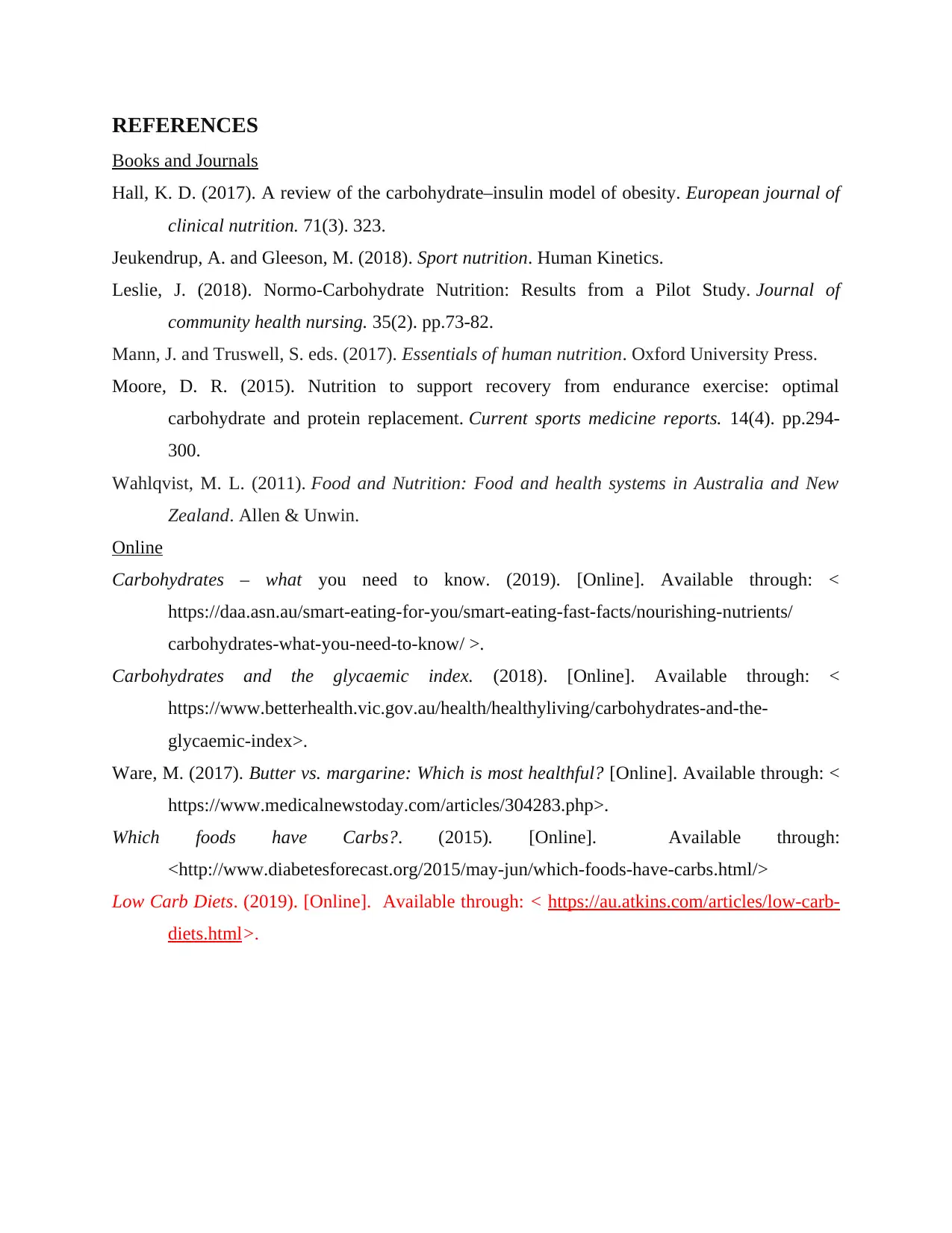
REFERENCES
Books and Journals
Hall, K. D. (2017). A review of the carbohydrate–insulin model of obesity. European journal of
clinical nutrition. 71(3). 323.
Jeukendrup, A. and Gleeson, M. (2018). Sport nutrition. Human Kinetics.
Leslie, J. (2018). Normo-Carbohydrate Nutrition: Results from a Pilot Study. Journal of
community health nursing. 35(2). pp.73-82.
Mann, J. and Truswell, S. eds. (2017). Essentials of human nutrition. Oxford University Press.
Moore, D. R. (2015). Nutrition to support recovery from endurance exercise: optimal
carbohydrate and protein replacement. Current sports medicine reports. 14(4). pp.294-
300.
Wahlqvist, M. L. (2011). Food and Nutrition: Food and health systems in Australia and New
Zealand. Allen & Unwin.
Online
Carbohydrates – what you need to know. (2019). [Online]. Available through: <
https://daa.asn.au/smart-eating-for-you/smart-eating-fast-facts/nourishing-nutrients/
carbohydrates-what-you-need-to-know/ >.
Carbohydrates and the glycaemic index. (2018). [Online]. Available through: <
https://www.betterhealth.vic.gov.au/health/healthyliving/carbohydrates-and-the-
glycaemic-index>.
Ware, M. (2017). Butter vs. margarine: Which is most healthful? [Online]. Available through: <
https://www.medicalnewstoday.com/articles/304283.php>.
Which foods have Carbs?. (2015). [Online]. Available through:
<http://www.diabetesforecast.org/2015/may-jun/which-foods-have-carbs.html/>
Low Carb Diets. (2019). [Online]. Available through: < https://au.atkins.com/articles/low-carb-
diets.html>.
Books and Journals
Hall, K. D. (2017). A review of the carbohydrate–insulin model of obesity. European journal of
clinical nutrition. 71(3). 323.
Jeukendrup, A. and Gleeson, M. (2018). Sport nutrition. Human Kinetics.
Leslie, J. (2018). Normo-Carbohydrate Nutrition: Results from a Pilot Study. Journal of
community health nursing. 35(2). pp.73-82.
Mann, J. and Truswell, S. eds. (2017). Essentials of human nutrition. Oxford University Press.
Moore, D. R. (2015). Nutrition to support recovery from endurance exercise: optimal
carbohydrate and protein replacement. Current sports medicine reports. 14(4). pp.294-
300.
Wahlqvist, M. L. (2011). Food and Nutrition: Food and health systems in Australia and New
Zealand. Allen & Unwin.
Online
Carbohydrates – what you need to know. (2019). [Online]. Available through: <
https://daa.asn.au/smart-eating-for-you/smart-eating-fast-facts/nourishing-nutrients/
carbohydrates-what-you-need-to-know/ >.
Carbohydrates and the glycaemic index. (2018). [Online]. Available through: <
https://www.betterhealth.vic.gov.au/health/healthyliving/carbohydrates-and-the-
glycaemic-index>.
Ware, M. (2017). Butter vs. margarine: Which is most healthful? [Online]. Available through: <
https://www.medicalnewstoday.com/articles/304283.php>.
Which foods have Carbs?. (2015). [Online]. Available through:
<http://www.diabetesforecast.org/2015/may-jun/which-foods-have-carbs.html/>
Low Carb Diets. (2019). [Online]. Available through: < https://au.atkins.com/articles/low-carb-
diets.html>.
⊘ This is a preview!⊘
Do you want full access?
Subscribe today to unlock all pages.

Trusted by 1+ million students worldwide
1 out of 12
Related Documents
Your All-in-One AI-Powered Toolkit for Academic Success.
+13062052269
info@desklib.com
Available 24*7 on WhatsApp / Email
![[object Object]](/_next/static/media/star-bottom.7253800d.svg)
Unlock your academic potential
Copyright © 2020–2025 A2Z Services. All Rights Reserved. Developed and managed by ZUCOL.

![Analysis of Carbohydrates in Human Body: Biology Report, [Date]](/_next/image/?url=https%3A%2F%2Fdesklib.com%2Fmedia%2Fimages%2Fnh%2F7b5ea273413144b985b8efdebb047dc4.jpg&w=256&q=75)



